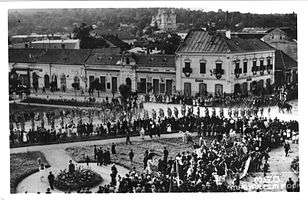Treznea massacre
| Treznea massacre | |
|---|---|
| Location | Treznea, Romania (Then Ördögkút, Kingdom of Hungary) |
| Date | 9 September 1940 |
Attack type | genocide (targeted killing of the local ethnic Romanians), ethnic cleansing |
| Weapons | machine guns, rifles, grenades, bayonets |
| Deaths | 93 ethnic Romanians and Jews |
| Perpetrator | Hungarian Army, locals |
The Treznea massacre occurred in the village of Treznea, Sălaj in north-western Transylvania on 9 September 1940, during the handing over of Northern Transylvania from Romania to Hungary after the Second Vienna Award. The circumstances of the massacre are controversial.[1]
The events

On that day, instigated by the former landlord Francisc (or Ferenc) Bay, the 22nd Hungarian Border Guards Battalion "Debrecen", led by Lieutenant-Colonel Ákosy, made a 4 km detour from the Zalău–Ciumărna–Hida route to exterminate the locals from the "Măgura" area of the commune, which formerly belonged to Francisc Bay.[2] The Hungarian troops entered the village at noon, the first victims being the children who pastured the animals.[2] The troops fired at will on the locals, killing many of them and partially destroying the Orthodox church. The sources recorded that 87 Romanians and 6 Jews were killed,[2] including the local Orthodox priest, Traian Costea, who was burned alive in his church, and the Romanian local teacher with his wife, Lazăr and Aurelia Cosma (the parents of the Romanian musicologist Octavian Lazăr Cosma).[2]
Some Hungarian historians claim that the killings came in retaliation after the Hungarian troops were fired upon by inhabitants, allegedly incited by the local Romanian Orthodox priest. These claims are not supported by the accounts of several witnesses.[2] The motivation of the 4 km detour of the Hungarian troops from the rest of the Hungarian Army is still a point of contention, as it could not have been as a routine occupation maneuver. Most evidence points towards the local noble Ferenc Bay who lost a large part of his estates to peasants in the 1920s, as most of the violence was directed towards the peasants living on his former estate.[2]
By the accounts of some witnesses, not all soldiers were wearing full uniform and some of them were drunk. Also, some villagers claim to have recognised some of the young men as locals from Zalău. This might suggest that not everyone in these Hungarian troops were operating under the jurisdiction of the Hungarian Army.
According to some historians, several Hungarian inhabitants of the village tried to stop the massacre, but they were themselves chased and beaten. Other source mentioned that a local Hungarian woman (out of the 10-15 Hungarian families living in the village) encouraged the killings by shouting to the troops: "Kill all the Romanians so that only us Hungarians will remain in the village".[3] Other source (Doctor Ioan Puşcaş) recalled that his knowledge of Hungarian and 2 Hungarian women from the village saved him from certain death.[4]
About 200 locals were rounded up and pushed towards a cliff, where they were to be machine-gunned. However, they were let go after the retreating Romanian Army, stationed nearby at Poarta Sălajului, threatened to intervene.
Aftermath
After the war, the Cluj People's Tribunal sentenced in this case and other war crimes 481 people, out of which 100 to death and 163 to life imprisonment. However most of them were trialed in absentia and never served their sentences.[2]
See also
Notes
- ↑ Ablonczy 2011, p.61
- 1 2 3 4 5 6 7 "75 de ani de la masacrul de la Treznea: 87 de români şi 6 evrei, ucişi la comanda unui moşier maghiar. "Pe fratele meu de 2 ani l-au împuşcat primul, în gură"" (in Romanian). Adevărul. 8 September 2015. Retrieved 22 August 2016.
- ↑ "Comemorarea martirilor de la Treznea a fost plina de amintiri infioratoare" (in Romanian). Graiul Sălajului. 10 September 2013. Retrieved 22 August 2016.
- ↑ "Castelul crimelor din Treznea este lăsat să moară" (in Romanian). Adevărul. 3 August 2011. Retrieved 22 August 2016.
References
- Maria Bucur. Treznea. Trauma, nationalism and the memory of World War II in Romania, Rethinking History, Volume 6, Number 1, April 1, 2002, pp. 35–55. doi:10.1080/13642520110112100
- Ablonczy (2011): Ablonczy Balázs. A visszatért Erdély 1940–1944 (magyar nyelven). Budapest: Jaffa Kiadó. ISBN 978 963 9971 60 8 (2011)
- (Romanian) Ip și Trăznea, Atrocități maghiare și acțiune diplomatică, Dr. Petre Ţurlea, ed. Enciclopedică, Bucureşti, 1996
- (Romanian) Ardealul pământ românesc. Problema Ardealului văzută de un american, Milton G. Lehrer, ed. Vatra Românească, 1991, ISBN 973-29-0010-5
- (Romanian) Urmaşii lui Atilla, Radu Theodoru, Editura Miracol, Bucureşti, 1999, ISBN 973-9315-38-0
- (Romanian) Teroarea horthysto-fascistă în nord-vestul României (septembrie 1940 - octombrie 1944), Mihai Fătu, Mircea Muşat (coord.), Ed. Politică, Bucureşti, 1985.